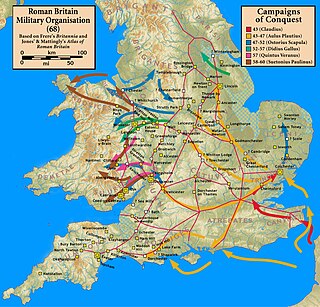
Gloucester is a cathedral city and the county town of Gloucestershire in the South West of England. Gloucester lies on the River Severn, between the Cotswolds to the east and the Forest of Dean to the west, 19 miles (31 km) east of Monmouth and 17 miles (27 km) east of the border with Wales. Including suburban areas, Gloucester has a population of around 132,000. It is a port, linked via the Gloucester and Sharpness Canal to the Severn Estuary.

Chepstow is a town and community in Monmouthshire, Wales, adjoining the border with Gloucestershire, England. It is located on the tidal River Wye, about 2 miles (3 km) above its confluence with the River Severn, and adjoining the western end of the Severn Bridge. It is the easternmost settlement in Wales, situated 16 miles (26 km) east of Newport, 28 miles (45 km) east-northeast of Cardiff, 18 miles (29 km) northwest of Bristol and 110 miles (180 km) west of London.

The London Wall is a defensive wall first built by the Romans around the strategically important port town of Londinium in c. AD 200, as well as the name of a modern street in the City of London, England.

Pedestrian zones are areas of a city or town restricted to use by people on foot or human-powered transport such as bicycles, with non-emergency motor traffic not allowed. Converting a street or an area to pedestrian-only use is called pedestrianisation.

Eastgate is a permanently open gate through the Chester city walls, on the site of the original entrance to the Roman fortress of Deva Victrix in Chester, Cheshire, England. It is a prominent landmark in the city of Chester and the Eastgate clock on top of it is said to be the most photographed clock in England after Big Ben.

Leicester City Centre is Leicester's historical commercial, cultural and transport hub and is home to its central business district. Its inner core is roughly delineated by the A594, Leicester's inner ring road, although the various central campuses of the University of Leicester, De Monfort University and Leicester College are adjacent to the inner ring road and could be considered to be a continuation of the City centre. In a similar way, the Leicester Royal Infirmary precinct, the New Walk business district (Southfields), the Welford Road Stadium of Leicester Tigers' RUFC and the King Power Stadium of Leicester City to the south, and the Golden Mile to the north could also be deemed to be extensions to the central core.

Chester city walls consist of a defensive structure built to protect the city of Chester in Cheshire, England. Their construction was started by the Romans when they established the fortress of Deva Victrix between 70 and 80 [CE]. It originated with a rampart of earth and turf surmounted by a wooden palisade. From about 100 CE they were reconstructed using sandstone, but were not completed until over 100 years later. Following the Roman occupation nothing is known about the condition of the walls until Æthelflæd refounded Chester as a burgh in 907. The defences were improved, although the precise nature of the improvement is not known. After the Norman conquest, the walls were extended to the west and the south to form a complete circuit of the medieval city. The circuit was probably complete by the middle of the 12th century.
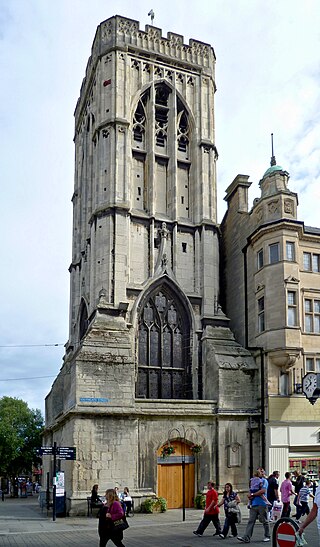
St Michael's Tower, Gloucester, stands at The Cross, where the four main streets of Gloucester meet. The Cross is also the highest point in the city. The Tower is on the corner of Eastgate and Southgate Streets and the entrance is in Southgate Street. It was built in 1465 on the site of the previous St Michael the Archangel. It is no longer used for religious ceremonies. It became a Grade II* listed building in 1952.

Streets in the British Overseas Territory of Gibraltar are represented by road signs as in the United Kingdom. As of 2007, Gibraltar has a network of 29 kilometres (18 mi) of roads.

Gloucester City Council is the local authority for Gloucester, a non-metropolitan district with city status in Gloucestershire, England.

Basildon Town Centre is a planned town centre developed during the creation of the town of Basildon, Essex, in the 1950s. The architect Sir Basil Spence worked on its design.
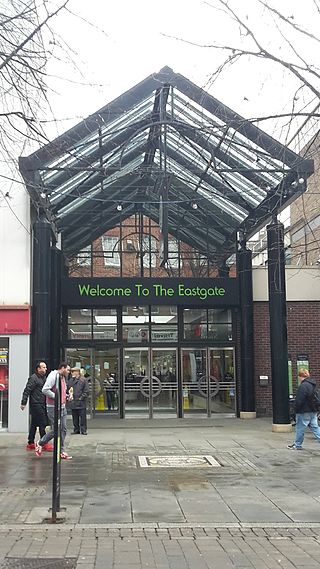
The Eastgate Shopping Centre is a two-story indoor shopping centre in Gloucester, England. It opened its portico entrance on 3 July 1973.
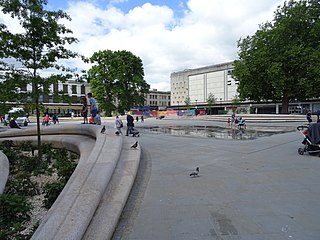
Kings Square is a market square in Gloucester, England connecting to Kings Walk Shopping Centre, Market Parade, The Oxbode and St Aldate Street.
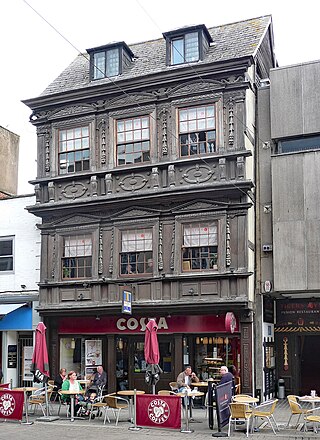
9 and 9A Southgate Street is a 17th-century Jacobean timber-framed merchant's house on Southgate Street, Gloucester. It has been a Grade I listed building since 23 January 1952. 9 Southgate Street is now occupied by Costa Coffee and 9A Southgate Street is occupied by The Tiger's Eye restaurant.

Brunswick Square is a 1.5-acre (0.61 ha) privately owned public garden with residential streets along three of its sides, in the English city of Gloucester. It is overlooked by the Christ Church to the east on Brunswick Road. The square is surrounded by terraced houses and flats with the Gloucester National Spiritualist Church on the north side and Gloucester House on the south side. There are nine grade listed buildings around the square. The square has been part of the Eastgate and St Michaels conservation area since 1968.

Gloucester Transport Hub is a bus station on Station Road in Gloucester, England.
Eastgate Street is one of the ancient streets in Gloucester, so named because its eastern end was originally the location of the east gate in the city's walls. The part beyond the gate as far as GL1 leisure Centre was part of Barton Street It runs from the crossroads of Northgate, Eastgate, Southgate and Westgate Streets in the West to Barton Street in the East.







